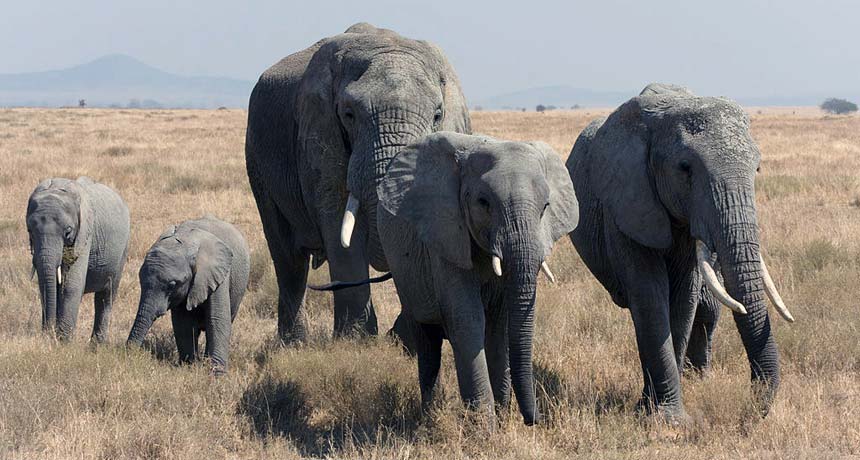Elephants appear to be super sniffers
Elephants have the most scent-capturing genes of any animal known

African bush elephants in the Serengeti of Tanzania.
Ikiwaner/ Wikimedia Commons
By Nsikan Akpan
Everyone knows that African elephants boast versatile snouts. They can toss logs, grab food and spray water. But the towering mammals also may be the world’s best smellers. That’s what scientists conclude in a July 22 report in Genome Research.
The team looked at bush elephants (Loxodonta africana). These are the larger of Africa’s two species. They tend to live in fairly open, grassy areas (hence the term “bush” in their common name). This species hosts some 2,000 different genes for sensing odors. Scientists refer to these sensors as olfactory receptors; olfaction (Oll-FAK-shun) refers to the sense of smell. These sensors are found on the outside of scent-sensing cells. They’re in a nasal cavity, near the top of the animal’s trunk.
Renowned sniffers like rats have around 1,200 genes for scent-sensing. Bloodhounds and other dogs get by with about 800 of these different genes. Humans and other primates possess relatively poor sniffers. They also have only about 40 olfactory genes.
The researchers think that long ago, when mammals split into a broad range of new species, the original smell-sensing gene began copying itself — and morphing somewhat — over and over again. This appears to have happened the most in ancestors of today’s elephants.
The elephant’s ability to detect a broad range of odors perhaps explains why scents play a big role in its behavior. African elephants, for instance, can communicate aggression via scents. And the animals also can distinguish people from two ethnic groups living near them in East Africa — the Maasai and Kamba. That’s helpful because the Maasai herders, in Kenya, hunt elephants. Mostly farmers, the Kamba pose no threat to the pachyderms.
Power Words
behavior The way a person or other organism acts towards others, or conducts itself.
cavity A large open region surrounded by tissues (in living organisms) or some rigid structure (in geology or physics).
gene A segment of DNA that codes, or holds instructions, for producing a protein. Offspring inherit genes from their parents. Genes influence how an organism looks and behaves.
genome The complete set of genes or genetic material in a cell or an organism.
nasal Having to do with the nose.
olfaction The sense of smell.
pachyderm A name for elephants and other nonruminant animals with hooves (or nails that look like them) and thick skin. A rhinoceros or hippopotamus also fits within this group, although most people use the term as a synonym for elephant.
receptor (in biology) A molecule in cells that serves as a docking station for another molecule. Thatsecond molecule can turn on some special activity by the cell.







